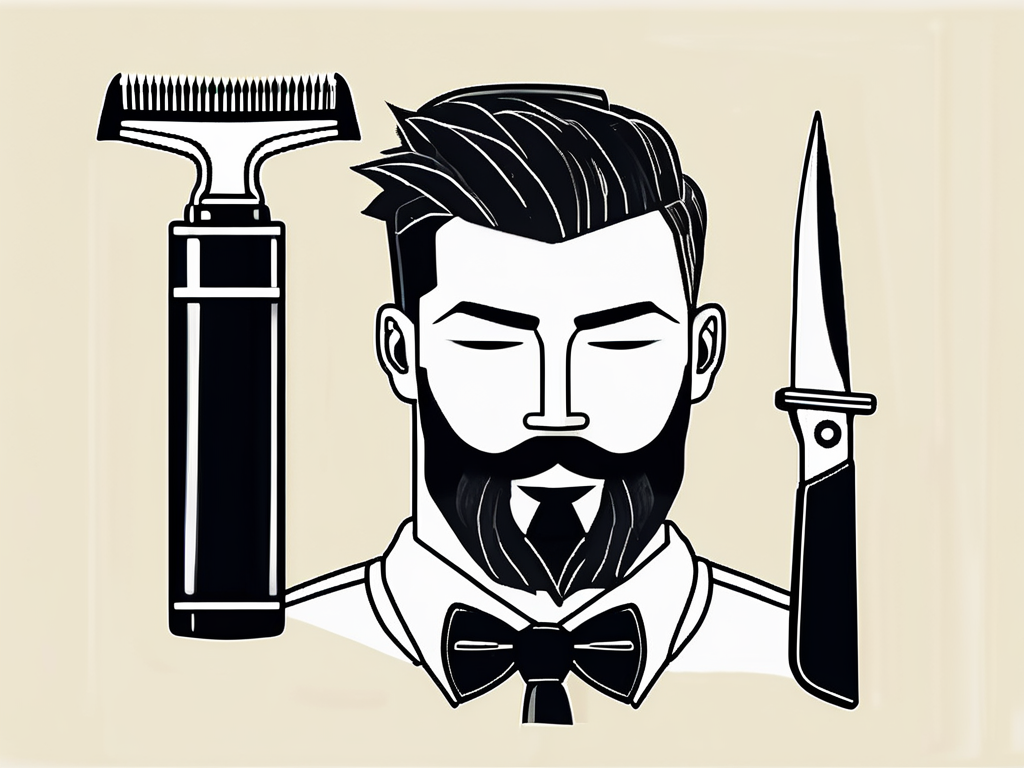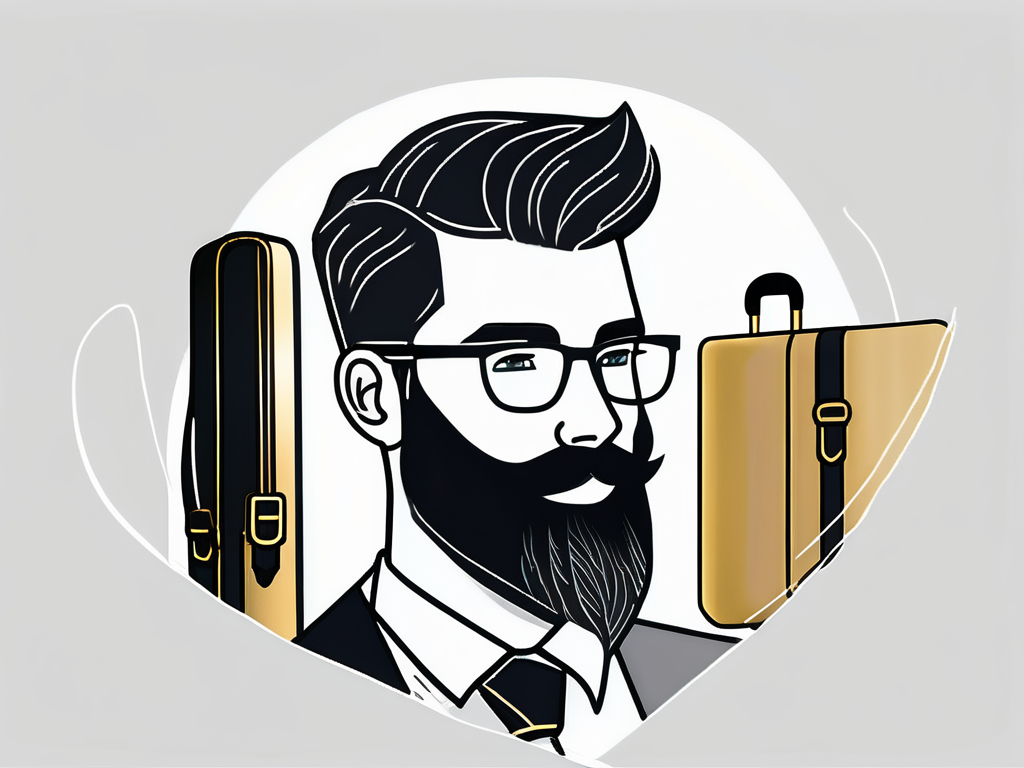Author: The Beard Struggle
Published at: Sep 13, 2024
Deciding whether to shave your beard before a job interview can feel like a monumental choice.
After all, your beard is more than just facial hair—it’s a part of your identity, your style, and perhaps even a symbol of your confidence. But as you prepare to step into that interview room, you might be wondering whether you should shave your beard for an interview or not.
Interestingly, studies have shown that first impressions are formed within the first seven seconds of meeting someone, and appearance plays a huge role in this snap judgment.
In this guide, we will:
The decision to shave your beard before a job interview is more than just a question of personal style; it’s a strategic choice that can influence how you're perceived by potential employers.
To make the best decision, you’ll need to evaluate your personal grooming standards, consider the stage of the interview process, and take into account any cultural or ethnic significance your facial hair might hold.
Let’s explore these factors in detail to help you navigate this decision with confidence.
Your beard can be a defining aspect of your appearance, but its impact on your professional image largely depends on how well it’s maintained. Before deciding whether to shave, take a critical look at your grooming habits:
A beard can enhance your appearance if it’s neat, evenly trimmed, and suits the shape of your face. However, if your beard is patchy, overgrown, or poorly groomed, it might send the wrong message in an interview.
Ask yourself if your current grooming routine is sufficient to keep your beard looking sharp and professional. If not, shaving might be a better option to ensure you present a polished and deliberate appearance.
Consider whether your beard aligns with the professional image you want to convey. In some industries, a beard can project confidence and maturity, while in others, it might be seen as less formal.
Reflect on how your facial hair might be perceived in the context of the job you’re applying for and whether it enhances or detracts from your overall presentation. If your beard adds to your professional presence, keeping it might be advantageous; if not, shaving could help you better fit the role’s expectations.
The stage of the interview process can also influence your decision to shave or keep your beard. Here’s how to navigate this consideration effectively:
The first interview is often the most crucial, as it sets the tone for how you’re perceived throughout the hiring process. During this initial stage, playing it safe by opting for a clean-shaven look might help you avoid any potential bias against facial hair, particularly in conservative industries.
A clean-shaven face can convey a strong commitment to professionalism and can help you make a solid first impression.
If you’ve made it to the follow-up stage, you might have a better sense of the company’s culture and expectations. At this point, if you’ve noticed that facial hair is common among current employees, you might feel more confident in keeping your beard.
However, if the environment still seems conservative or if you’re unsure, continuing with a clean-shaven look might be the safer choice to maintain the momentum you’ve built.
In the final stages, where the focus is more on cultural fit and closing the deal, you might feel comfortable reintroducing your beard, especially if you feel it’s an important part of your identity.
By this point, the rapport you’ve built with the interviewers might allow for more flexibility in your appearance, as long as it remains well-groomed and professional.
Facial hair can carry significant cultural, ethnic, or religious meanings, which adds another layer of complexity to the decision of whether to shave for an interview. Here’s how to navigate this aspect thoughtfully:
For many, facial hair isn’t just a style choice—it’s a reflection of cultural heritage or religious beliefs. If your beard holds such significance, it’s important to weigh this against the expectations of the professional environment you’re entering.
In most cases, employers are required to respect cultural and religious practices, but it’s still crucial to consider how best to present this aspect of your identity in a professional context.
If your beard is a key part of your cultural or religious identity, you might consider discussing this openly if it becomes relevant during the interview process.
Employers who value diversity and inclusion will likely appreciate your transparency and respect your decision to maintain your facial hair. However, ensure that your beard is well-groomed to align with the professional standards of the workplace, showing that you’ve made a deliberate and thoughtful choice.
Unfortunately, bias—conscious or unconscious—can still exist regarding facial hair that is culturally or religiously significant.
If you suspect this might be a factor, you could weigh the importance of the role and the company’s values against your need to maintain your beard. If the company demonstrates a commitment to diversity, it’s likely a place where you can express your cultural or religious identity without concern.
The decision to shave or keep your beard before an interview is deeply personal, yet it requires careful consideration of various factors.
By evaluating your grooming standards, considering the stage of the interview, and reflecting on the cultural or ethnic significance of your facial hair, you can make a decision that balances your personal identity with professional expectations.
Ultimately, the goal is to present yourself in a way that aligns with both your values and the demands of the job, ensuring you walk into the interview with confidence and poise.
While beards have gained acceptance in many professional settings, there are still situations where a clean-shaven look might give you an edge. Understanding these scenarios can help you make the best decision for your career prospects.

âš ï¸ Safety First: In these industries, hygiene and safety trump personal style preferences.
💡 Insight: The key is to match the expectations of the client base you'll be serving.
​💡 Key Action: Always ask about grooming policies during the application process.
🪒 Quick Fix: When in doubt, a clean shave can provide a neat, uniform look.
Understanding industry-specific perceptions can guide your grooming decisions. Let's explore how facial hair might be viewed across various sectors:
Ultimately, your skills, qualifications, and interview performance will likely outweigh your facial hair choices. However, aligning your appearance with the company's expectations can help eliminate potential biases and let your talents shine through.
Whether you decide to shave or keep your beard, remember that confidence is key. Choose the option that makes you feel most self-assured and professional. Your comfort and confidence will radiate through your interview performance, facial hair or not.

Deciding to shave your beard before a job interview can be a significant step towards presenting a clean, polished appearance that aligns with professional expectations.
However, it’s essential to approach this process with care to avoid irritation, cuts, or any signs of discomfort that could detract from your look on interview day.
Whether you’re shaving for the first time in a while or just refining your regular routine, following proper shaving and skincare techniques is crucial. Here’s how to ensure a smooth shave and maintain a fresh, professional appearance afterward.
Shaving might seem straightforward, but there are specific steps you can take to ensure the best results—especially when preparing for something as important as a job interview.
Proper shaving technique can prevent common issues like razor burn, nicks, and irritation, leaving your skin smooth and clear.
Start with a Hot Shower or Warm Towel: Before you begin shaving, it’s essential to soften your facial hair and open up your pores. The best way to do this is by taking a hot shower or applying a warm towel to your face for a few minutes. This step makes the hair easier to cut and reduces the risk of irritation. Softened hair also helps the razor glide more smoothly, reducing the chance of nicks and cuts.
Use a Quality Shaving Cream or Gel: Choosing the right shaving cream or gel is crucial for a smooth shave. Opt for a product that provides plenty of lubrication and contains moisturizing ingredients to protect your skin. Apply it evenly over the areas you plan to shave, ensuring a rich lather that will help the razor move effortlessly across your skin.
Shave with the Grain: One of the most important rules of shaving is to go with the grain of your hair—that is, in the direction your hair naturally grows. Shaving against the grain might give a closer shave, but it also increases the risk of razor burn and ingrown hairs. Start with gentle strokes and avoid pressing the razor too hard against your skin, as this can lead to cuts and irritation.
Rinse the Razor Frequently: To maintain a clean, effective shave, rinse your beard razor after every few strokes. This helps remove hair, cream, and dead skin cells that can clog the blades, making it harder to achieve a smooth shave. A clean razor reduces the risk of dragging or pulling the skin, which can cause discomfort and blemishes.
Rinse with Cold Water Post-Shave: After you’ve finished shaving, rinse your face with cold water to close your pores and soothe the skin. This step also helps to remove any residual shaving cream or hair, ensuring your skin is clean and ready for post-shave care.
The way you care for your skin after shaving is just as important as the shaving process itself. Proper post-shave care can prevent irritation, reduce redness, and keep your skin looking fresh and professional.
Apply an Alcohol-Free Aftershave: Many traditional aftershaves contain alcohol, which can dry out the skin and cause a stinging sensation—especially on freshly shaved skin. Instead, opt for an alcohol-free aftershave balm or lotion that soothes and moisturizes. Look for ingredients like aloe vera, chamomile, or witch hazel, which are known for their calming properties. This will help to reduce any post-shave redness and irritation, leaving your skin feeling smooth and comfortable.
Moisturize Thoroughly: Shaving can strip your skin of its natural oils, making it essential to moisturize afterward. Use a lightweight, non-greasy moisturizer that suits your skin type—whether it’s dry, oily, or sensitive. You can even try applying a beard mask for dry skin. This will help to replenish moisture, create a protective barrier, and keep your skin looking hydrated and healthy. Well-moisturized skin also gives you a more polished and professional appearance, which is key for making a great impression in your interview.
Treat Any Nicks or Irritation Promptly: Despite your best efforts, minor nicks or irritation might occur during shaving. If this happens, treat the affected areas promptly to prevent them from becoming more noticeable. Use a styptic pencil or alum block to stop any bleeding, and apply a soothing balm or antiseptic cream to reduce redness and irritation. Avoid touching or scratching the area, as this can lead to further inflammation or scarring.
Exfoliate Regularly: In the days leading up to your interview, consider exfoliating your skin to remove dead cells and prevent ingrown hairs. Exfoliation helps to keep your skin smooth and clear, allowing for a more even shave and a brighter complexion. However, be gentle with exfoliation and avoid doing it immediately after shaving to prevent irritation.
If you choose to shave your beard before an interview, taking the time to do it properly can make all the difference in your appearance.
By following a careful shaving routine—starting with softening your facial hair and ending with proper post-shave skincare—you can achieve a smooth, irritation-free shave that leaves your skin looking fresh and professional.
Remember, a well-maintained, clean-shaven face can project the polished, confident image you want to convey in your interview, helping you make the best possible impression.
Ultimately, the decision to shave or keep your beard for an interview is a personal choice that should align with both your authentic self and the professional expectations of your industry.
By considering factors like company culture, grooming norms, and your own values, you can make an informed decision that showcases your best self. Whether you choose to rock a well-maintained beard or opt for a clean-shaven look, remember that confidence is key.
By taking the time to properly groom your facial hair or master the art of shaving, you'll walk into your interview feeling self-assured and ready to impress.
Ready to perfect your grooming game? Explore more tips and premium products at The Beard Struggle to help you look and feel your best.

10 Beard Care Mistakes A Viking Should Never Make
Register now to receive 10 exclusive tips straight to your inbox.
Comments